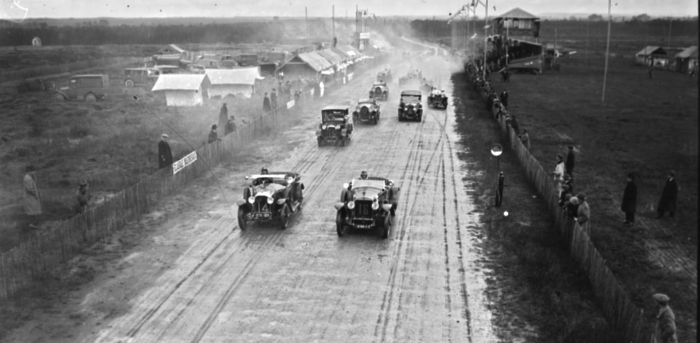1923 - 2023, 100 Years of a Legendary Race (1 / 6)
The first edition of the 24 Hours of Le Mans took place on May 26 and 27, 1923. It remains today still as the most prestigious endurance car race in the world. Its Centenary is an opportunity to review in Gallica its fascinating history.
The Sarthe County in western France is renowned for its agriculture and regional gastronomy. In a lesser extend it is also known for one of the most iconic invention of our modern times: the automobile – symbol of freedom, mobility, economic and societal development.
In October 1875, Amédée Bollée, living the Sarthe County, arrives in Paris with L’Obéissante (trad. The Obedient), a steam vehicle, which is today considered as the first individual car ever built (invented in 1873). The 200 km long journey from the city of Le Mans to Paris set a milestone for the entire automobile industry of that time and led a lot of other manufacturers to start building and setting up their own car models afterwards.
The first steam vehicle "l'Obeissante", Meurisse Press Agency
The development of the automobile gets to such a level that in 1905, the Automobile Club de France (ACF) – which its actual headquarters are located Place de la Concorde, downtown Paris – launches a tender for the organisation and the management of the first speed car race on a closed circuit. The city of Le Mans was eventually selected.
Following that selection, a small group of automobile enthusiasts are forming the Automobile Club de la Sarthe (which starting from 1913 was renamed Automobile Club de l’Ouest - ACO).
Its first president was the local entrepreneur Adolphe Singher then director of Mutuelle mobilière du Mans (which decades later became the insurance company Les Mutuelles Du Mans Assurances – MMA), the engineer Georges Durand as secretary and Amédée Bolée with his son Léon among its members. The Automobile Club de la Sarthe organizes the first Grand Prix of ACF at Le Mans in June 26-27, 1906. The race was run on a two-day format for 12 laps (6 laps per day). Its first winner was the Hungarian driver Ferenc Szisz driving a Renault.
Singher, portrait of the president of the Automobile Club de l' Ouest during the race in Laval
The La Sarthe race track was at that time a 100 km long triangle (between Le Mans, Saint-Calais and La Ferté-Bernard). Thirty-three competitors were present at the start of this race, which is considered today as the first car competition organized on a closed circuit, and the ancestor of nowadays Formula One Grands Prix.
After this event, the Automobile Club de l’Ouest (ACO) successfully manages to highlight the continuous progress and inventions of the automobile industry at this beginning of the XXth century, and has brought a valuable contribution to the promotion of the individual car in its different purposes: daily use, recreational or motorsports. The ACO has also been a pioneer of advertising campaigns for the automotive industry, the road safety or the juridical assistance in case of crash.Then, in 1922 after having organized other speed races and events (Grand Prix de la Consommation, Grand Prix de l’ACF again in 1921…) engineer Georges Durand general secretary of the ACO, together with the well-known journalist Charles Faroux and the entrepreneur Émile Coquille are presenting during the Paris Motor Show their idea of organizing a nonstop 24 hours race.
Mr. Georges Durand, General Secretary of the Automobile Club de l'Ouest, Le Mans, June 10, 1926
Charles Faroux in the pits, Circuit de la Sarthe, Agence Rol
This new kind of competition is accelerating furthermore the development of the automobile technology and engineering. It is also the first time that the endurance of both cars and drivers (and not only pure speed) represent a key success factor.












 Cultural Olympiad is a multidisciplinary artistic and cultural program which runs from the end of the previous Games to the end of the Paralympic Games.
Cultural Olympiad is a multidisciplinary artistic and cultural program which runs from the end of the previous Games to the end of the Paralympic Games.